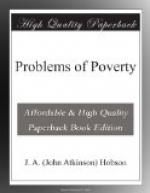Though the method of assessing companies as if they were single persons renders it impossible to obtain accurate information in recent years as to the number of persons enjoying incomes of various sizes, a comparison made by Mr Mulhall of incomes in 1867 and 1895 indicates that, while the lower middle-class is growing rapidly, the number of the rich is growing still more rapidly. While incomes of L100 to L300 have grown by a little more than 50 per cent., those from L300 to L1000 have nearly doubled, those between L1000 and L5000 have more than doubled, and incomes over L5000 have more than trebled.
But though such comparisons justify the conclusion that the upper grades of skilled labour have made considerable advances, and that the lower grades of regular unskilled labourers have to a less degree shared in this advance, they do not warrant the optimist conclusion often drawn from them, that poverty is a disease which left alone will cure itself, and which, in point of fact, is curing itself rapidly. Before we consent to accept the evidence of improvement in the average condition of the labouring classes during the last half century as sufficient evidence to justify this opinion we ought to pay regard to the following considerations—
1. It should be remembered that a comparison between England of the present day with England in the decade 1830-1840 is eminently favourable to a theory of progress. The period from 1790 to 1840 was the most miserable epoch in the history of the English working-classes. Much of the gain must be rightly regarded rather as a recovery from sickness, than as a growth in normal health. If the decade 1730-1740, for example, were to be taken instead, the progress of the wage-earner, especially in southern England, would be by no means so obvious. The southern agricultural labourer and the whole body of low-skilled workers were probably in most respects as well off a century and a half ago as they are to-day.




